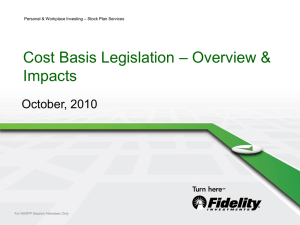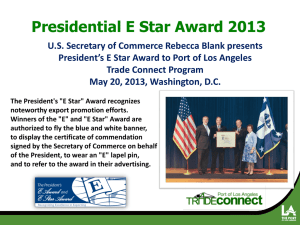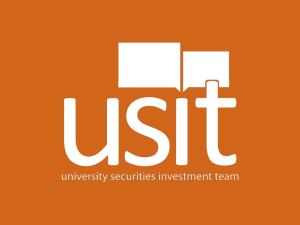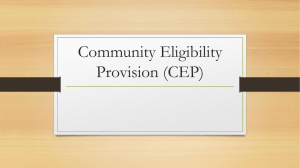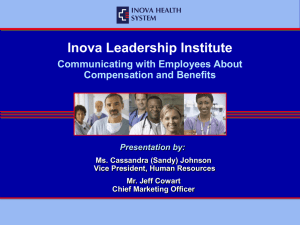e3474_November_13__2012_MI_Chapter_NASPP_Presentation
advertisement
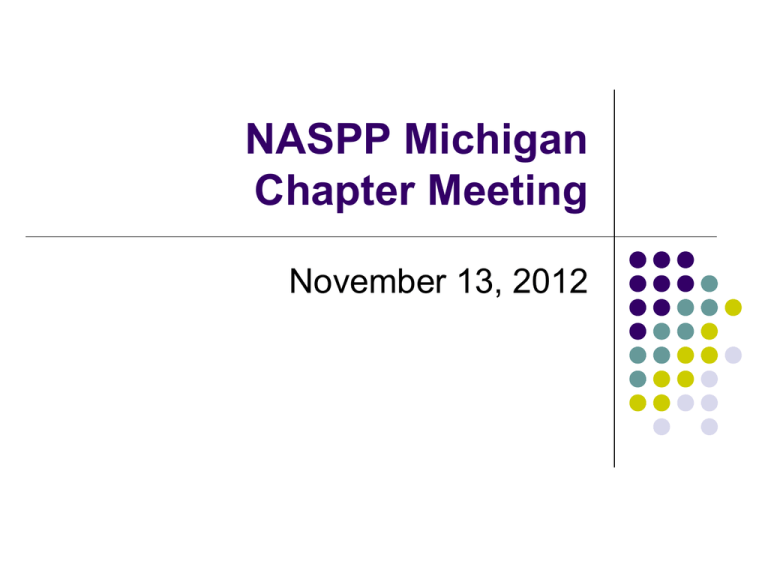
NASPP Michigan Chapter Meeting November 13, 2012 Chapter Announcements NASPP Memberships It’s renewal time! All NASPP memberships expire on December 31 Renew today to avoid the last minute rush and make sure you don’t miss any of the great webcasts planned for next year Renew at Naspp.com Chapter Announcements NASPP Conference Audio All NASPP Conference session are recorded; audio is available for purchase after the Conference A great way to experience the Conference, catch up on industry developments, and hear some of the fabulous sessions presented by the industry’s top speakers NASPP members can purchase a single session for just $65, additional discounts are available for multi-session purchases Visit Naspp.com after the Conference to purchase the audio Chapter Announcements Introducing the NASPP Career Center Post a job, post your resume details, browse jobs and gain valuable career information Web site highlights Free Job Bank: Any employer (NASPP member or not) can post an industryrelated position Chapter Job Board: Positions listed in our chapter area. When posting a job, you can associate it with up to three chapters Resume Bank: Active NASPP members can post a resume profile for visibility to employers looking to fill job openings; resumes are searchable by those with access to the Career Center Message Center: Central messaging area for communication between resume posters and employers, as well as email updates about new job openings or candidates that match your search criteria Move forward in your career now by visiting the NASPP’s Career Center today at: http://www.naspp.com/CareerCenter/ Chapter Announcements Are you on Facebook or Twitter? The NASPP is too! Follow the NASPP on Twitter or “like” us on Facebook The NASPP posts announcements whenever we post new content on Naspp.com--it's a great way to keep up with all the content we have on the website Current Facebook friends The NASPP requests and encourages your further presence on our Facebook page Respond to new interactive questions and/or “like” our posts as you feel appropriate Visit the NASPP’s Facebook page today at: http://www.facebook.com/NASPP Highlights from the 20th Annual NASPP Conference October 8th-12th New Orleans Presented by: Erin Newell, CEP Alicia Mladsi, CEP Making Your Vendor Relationships More Effective Larry Petz, CEP, Dana Holding Corp Erin Madison, CEP, Broadcom John Hammond, CEP, AST Equity Plan Solutions Jen Baehr, CEP, NASPP Making Your Vendor Relationships More Effective Service Options Outsourcing Self-Administration Partial Administration Multi-vendor Brokers Record-keeping Tax/Legal Merchant Bank (India) Trustee (Israel) Making Your Vendor Relationships More Effective Service Definition in the contract Anyone involved in Equity should be included in the contract process Attorneys will focus on legal language Service Level Agreement, often not standard and should be requested in the contact Making Your Vendor Relationships More Effective Implementation of new vendor Understand services & capabilities Ask questions Request references Current Vendors Schedule periodic meetings Make suggestions for future enhancements Training classes Advisory Boards Preserve Your Reserve (and your Sanity) Megan Arthur, Cooley LLP Denise Miller, Adobe Systems Incorporated Scot Witz, W.W. Grainger, Inc Julie Mrozek, Stock & Option Solutions, Inc. Fungible Share Reserve Design “Full Value” awards (Restricted stock, RSUs, Performance shares, etc.) count as more than one share Example: Share reserve consists of 10M new shares with a 2 to 1 ratio for full value awards: Stock options covering 10M shares may be issued OR Full-value awards covering 5M shares OR Some combination of full-value awards and options Fungible Share Reserve Design Where does the ratio come from? Most often, from an ISS derived “value-neutral” ratio for determining the “cost” of the share increase, based on the ratio of the value of a full value award and an option/SAR award under the ISS proprietary model What is ISS? Institutional Shareholder Services (“ISS”, a division of RiskMetrics Group) - a leading provider of corporate governance data and investment decision support tools Fungible Share Reserve Design – Adobe Systems Have multiple plans with multiple sets of ratios Tracking is done by: Placing fungible ratios in a user defined field on each grant record Filtering on this field for reporting Reconciliation Example of Fungible Share Pool Tracking Share Counting - Liberal Only shares actually issued reduce the share reserve. Reserve is nt reduces by any shares subject to all types of stock awards that: Expire or terminate Are settled in cash Are forfeited back to or repurchased by the company Are reacquired by the company in satisfaction of tax withholding obligations or as consideration for the exercise or purchase price of the stock award. Share Counting – Non-Liberal Non Liberal Share counting: ISS and other proxy advisory firm policies Liberal share counting will result in higher “cost” of the plan To avoid higher cost, reserve must be reduced by any shares that: Are not issued because they are used for a net exercise Are reacquired by the company in satisfaction of tax withholding obligations or as consideration for the exercise or purchase price of an option or stock appreciation right. The Future of Equity Compensation James Humza, Bank of America Merrill Lynch Kurt Bremer, Morgan Stanley Smith Barney Jim Wilforst, ETRADE Corporate Services Moderated by, Elizabeth Doge, CEP, Stock & Option Solutions The Future of Equity Compensation What are your thoughts about the future direction of outsourcing plan administration? Outsource will continue, forced to do more with less War for talent ‘Right Sourcing’ – finding the right solution The Future of Equity Compensation What are the greatest overall challenges facing the equity compensation industry today? War for talent Education & Tax Planning The Future of Equity Compensation What are the most significant challenges of global stock plans & how do you envision our industry rising to those challenges? Mobility- need to automate Communication & Education- translation Equity Compensation Crossfire: Cutting-Edge Plan Design Terry Adamson, Aon Hewitt Barbara Baksa, NASPP Jennifer Kirk, Google Michael Mclanahan, Fidelity Russell Miller, ClearBridge Compensation Equity Compensation Crossfire: Cutting-Edge Plan Design Grant Frequency Cash Settled Automated Execution Equity Choice Capped Awards Equity Compensation Crossfire: Cutting-Edge Plan Design Typical Annual Grants More Frequent Quarterly or Semiannually Administrative Challenges Less Frequent Grant intended to span several years (i.e. Steve Jobs) Governance challenges Cash Settled Awards Can be authorized under plan but cash (rather than shares) used to settle the award Cash settled RSUs Cash settled SARs Cash Payment not from a market sale of stock Different accounting treatment Paying out cash and have no control how much Automatic Exercise Administrative feature designed to ensure that a participant’s in-the-money grants are exercised automatically at point of expiration Typically plan sponsor set percentage or dollar amount where auto exercise occurs $0.50 per share ($20 grant exercises at $20.50) 1% trigger ($20 grant exercises at $20.20 FMV) Equity Choice Program Allow employees to choose the type of award they receive Choices might include options, full value awards, performance awards, cash Size of award adjusted commensurately so that employees receive same grant value regardless of choice (i.e. Solium plan is 3 options to 1 RSU) NOTE: Need to educate employees on tax and legal consequences. Capped Awards May be allowing payout of cash and don’t want to have uncontrolled amount of distribution Limits effects of dilution for share payouts Value & Valuations: Making Sense of Long-Term Incentive Data Terry Adamson, Aon Hewitt Billy Vitense, Starbucks Fred Whittlesey, Compensation Venture Group Value & Valuations: Making Sense of Long-Term Incentive Data Starbucks Coffee Company How partners perceive value? Show partners how economic value is translated to # of shares Stock Options Performance RSU Value & Valuations: Making Sense of Long-Term Incentive Data Make it clear on upcoming events Provide schedule of grants & vesting 5 P’s- Proper Planning Prevents Poor Performance Planning leads to overall goal of creating Financial Wellness Paying for Performance in an Unpredictable Market Yonat Assayag, Clearbridge Compensation Group Mark Borges, Compensia Rose Marie Orens, Compensation Advisory Partners Paying for Performance in an Unpredictable Market Shareholders demanding more evidence that executive pay is aligned with company performance Increased use of performance based Long Term Incentives Improved disclosure Companies are challenged with effective performance measurement / goal setting process Paying for Performance in an Unpredictable Market Incentive measure selection requires balancing the shareholder and executive perspectives Shareholders: Want concrete results that justify cash payments or ownership dilution Executives: Want to be motivated to increase company value Paying for Performance in an Unpredictable Market Key considerations Possible performance measures Performance measurement timeframes Goal setting Pay / performance relationship Identifying Incentive-Based Performance Measures Why stock price is not always the answer Management’s day to day decisions are not immediately reflected Measures should be under the control of the executive and be correlated with shareholder return in the long run Selection should take into account the incentives “motivational impact” on various participant types Evaluating Different Measures Total Shareholder Return (TSR) With Pricebegin = share price at beginning of period, Priceend = share price at end of period, Dividends = dividends paid and TSR = Total Shareholder Return, TSR is computed as: TSR = (Pricebegin – Priceend + Dividends ) / Pricebegin Evaluating Different Measures Total Shareholder Return (TSR) Advantages Gets to the heart of what investors desire Easy to calculate and communicate Can’t be manipulated Disadvantages Still uses stock price as a component, which does not reflect managements day to day decisions and includes market conditions not in control of management Evaluating Different Measures Revenue Advantages Rewards “top line” performance/growth of the company Ideal for developing companies with the only objective to build scale and market share Aligns to outcomes that executives can directly impact Easy to measure and understand Disadvantages Ignores several important factors such as costs of goods sold, tax strategies, etc. Does not reward for managing the other aspects of the business and may discourage leadership decisions Evaluating Different Measures Gross Profit Advantages Aligns to outcomes that executives can directly impact Easy to measure and understand Encourages selling more product at the highest martin possible Disadvantages Does not reward for managing other aspects of the business May discourage leadership decisions Evaluating Different Measures Earnings before interest taxes depreciation amortization (EBITDA) Advantages Encourages selling more product at the highest cash operating margin Excludes legacy decisions such as capital expenditures, acquisitions, financing and tax strategies that may take away from current operating achievements A good short term measure of operating performance Disadvantages Requires calculation rather than a reported number Ignores several important factors such as costs of goods sold, tax strategies Effective Goal Setting in a Volatile Market Proper alignment of threshold, target and superior performance and payouts is critical Typically threshold performance levels are very achievable (85% - 90% chance of achievement) Target performance levels are more difficult to achieve (~60%) Maximum performance levels represent “stretch” and are very difficult to achieve (10-15% chance) Top 10 Pay for Performance Pitfalls to Avoid 1. 2. 3. 4. 5. 6. 7. 8. 9. 10. Wrong Measure Right Measure, Wrong Goal Right Measure, Wrong Behavior Not Enough Stretch Too Much Stretch Paying Below Street Guidance The “Perfect” Measure vs. the “Right” Measure Pay for Failure Poor Disclosure No Surprises!! Withhold Now Or Forever Speak Your Piece William Dunn, PricewaterhouseCoopers LLP Wendy Jennings, Riverbed Technology, Inc. Ameena Majid, Seyfarth Shaw LLP Donna Spinola, McKesson Corporation Withhold Now Or Forever Speak Your Piece General Administrative Considerations Timeline Communicate Choices vs. Requirements Withhold Now Or Forever Speak Your Piece Share Withholding vs. Sell to Cover Pros and cons of each Cash Withholding FICA withholding for retirees Rule of Administrative Convenience Delay the timing in which employer make take into account deferred amounts, no later then end of calendar year International withholding for ESPP Withhold Now Or Forever Speak Your Piece ISO General rule, no withholding for ISO Pennsylvania does require withholding Managing Mobile Employees at Home and Abroad Scott Sander – Amazon.com Mark Miller – Deloitte Tax LLP Rive Rutke – Deloitte Tax LLP Managing Mobile Employees There is an increasing need for countries to find new sources of revenue. According to CIA World Fact Book, government spending exceeds revenues in numerous countries including: United Kingdom 26% United States 60% Australia 11% ● India 47% ● Ireland 94% ● Japan 25% Why is this my problem? Mobile employees may trigger tax withholding and reporting obligations for the employer in multiple jurisdictions Global tax withholding and reporting failures in the employee tax burden passing to the employer HR impact can be as painful as the tax penalties Amazon Case Study Grant broad based RSUs to employees in 29 countries and notable locations include US, UK, Lux, Germany, India, Japan and China Ownership is a fundamental leadership principle at Amazon Equalization practice for mobile employees (net pay adjustment) Amazon Case Study Multiple vendor approach to due diligence Identification of key stakeholders and formalized process to review guidance (Payroll, Legal, Corp Tax, Acctg) Arrive at defensible tax position that aligns with organizational philosophy. Practical Guidelines/Summary Full compliance may not be achievable; nor is automation right for everyone Identify how your company can track movers Identify larger “risk” states/countries Review and understand withholding and reporting obligations Review and understand where state tax credits/reverse credits or reciprocity may help to reduce double taxation Determine how your company will develop a process to balance the technical requirements with administrative abilities Keeping Up with the Updates Jennifer Namazi, NASPP Louis Rorimer, Jones Day Shoshana Litt, Jones Day Marlene Zobayan, Rutlen Associates LLC Brian Buggy, Matheson Ormby Prentice Keeping Up with the Updates The NASPP Global Stock Plans Portal Country Specific Guides 33 countries Alerts Countries with most alert subscribers: 1. 2. 3. 4. UK Canada Germany China Keeping Up with the Updates Other Resources Newsletter Alerts Local Contacts Webinars, Seminars, Conferences The Cash Alternative: What, When and How Myrna Hellerman, Sibson Consulting Takis Makridis, Equity Methods LLC Thomas Welk, Cooley LLP The Cash Alternative In recent years, economic challenges and new governmental mandates called into question the typical incentive design As a result, many companies have moved away from the Standard Design. They have adopted Alternative Hybrid Approaches. The Cash Alternative Cash Settled RSU Cash Settled SAR Standard ‘Restricted stock unit that is settled in cash based on the equity value at settlement Tracks appreciation of equity but paid in cash Option based award in which the appreciation over the strike price is paid in cash Capped Cash Settled SAR SAR in which the payout may not exceed a certain level (price ceiling) The Cash Alternative Cash Based Award (i.e. RCU) Cash denominated award, so does not track appreciation or depreciation in equity value (may contain performance or market conditions) Hybrid (Floating) Award Award that is structured so that elected payout method may be modified during the vesting period as expectations change regarding treasury shares on hand for use Implications and Considerations Who determines the settlement method, company or employee and when? If employee, triggers liability accounting Measurement date is the settlement date, not grant date. This means the fair value needs to be remeasured each period until settlement Result is ongoing cumulative-effect adjustments (mark to market accounting) Note that if choice not at grant, probably 409A considerations Providing employees choice precludes establishment of a grant date until election, so perhaps best to elect prior to the grant Implications and Considerations Must the awards, if paid in equity, be from a shareholder approved plan? What are the registration requirements, if any? What are the reporting obligations? (e.g. Section 16) What tax benefits/drawbacks are there to the award (and is the employee aware of these?) Other Updates 2013 Conference Location Washington DC Contact Info Erin Newell, CEP Account Manager Solium Office: 480-308-8174 Email: erin.newell@solium.com Alicia Mladsi, CEP Strategic Client Manager Solium Office: (203) 447-5845 Email: alicia.mladsi@solium.com
